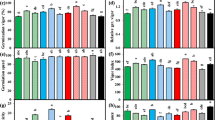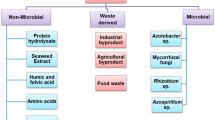Abstract
Hormesis is a dose–response phenomenon that is characterized by stimulation at low doses and inhibition at high doses. Extensive evidence has accumulated showing the occurrence of hormesis in numerous plant species independent of physicochemical agents, and this phenomenon has become a target for achieving greater crop productivity. Biostimulants (i.e., elicitors) are agents that activate adaptive responses, moderately stimulate biological performance and aid plants in tolerating stress when applied at low doses that fall within the stimulatory zone of a dose–response curve. Biostimulants based on seaweed liquid extracts (SLEs) are widely known to exert great benefits in plants at very low doses. However, the consequences to plants when SLEs are applied at high doses remain underexplored. A dose–response study was performed on mung bean (Vigna radiata) seedlings by applying a wide range of SLE doses to evaluate growth stimulation patterns. While the application of SLEs at high concentrations mostly caused a decrease in various morphological parameters, the application of SLEs at low concentrations stimulated some of these. Nevertheless, common features of SLE stimulation were present. Mung bean shoot length, root length, and dry weight responded to the SLE concentrations in a hormetic manner. A biphasic dose–response confirmed the relationships between SLE dose and mung bean plant growth parameters, which were due to the properties of the constituents of the SLE of each seaweed species. The SLE growth stimulation pattern found in this study will contribute to the establishment of safe application doses. This paper provides a strong foundation for enhancing the research protocols of studies on the effects of SLEs on plant growth and supports incorporating hormesis into risk assessment practices in agriculture.



Similar content being viewed by others
References
Agathokleous E, Calabrese EJ (2019a) Hormesis: the dose response for the 21st century: the future has arrived. Toxicology 425:152249
Agathokleous E, Calabrese EJ (2019b) Hormesis can enhance agricultural sustainability in a changing world. Global Food Secur 20:150–155
Agathokleous E, Kitao M, Calabrese EJ (2018a) Human and veterinary pharmaceuticals induce hormesis in plants: scientific and regulatory issues and an environmental perspective. Environ Int 120:489–495
Agathokleous E, Kitao M, Calabrese EJ (2018b) The rare earth element (REE) lanthanum (La) induces hormesis in plants. Environ Pollut 238:1044–1047
Agathokleous E, Belz RG, Calatayud V, De Marco A, Hoshika Y, Kitao M, Saitanis CJ, Sicard P, Paoletti E, Calabrese EJ (2019a) Predicting the effect of ozone on vegetation via linear non-threshold (LNT), threshold and hormetic dose-response models. Sci Total Environ 649:61–74
Agathokleous E, Belz RG, Kitao, Kitao M, Koike T, Calabrese EJ (2019b) Does the root to shoot ratio show a hormetic response to stress? An ecological and environmental perspective. J For Res 30:1569–1580
Agathokleous E, Feng ZZ, Iavicoli I, Calabrese EJ (2019c) The two faces of nanomaterials: a quantification of hormesis in algae and plants. Environ Int 131:105044
Agathokleous E, Kitao M, Calabrese EJ (2019d) Hormesis: a compelling platform for sophisticated plant science. Trends Plant Sci 24:24–37
Agathokleous E, Kitao M, Calabrese EJ (2019e) Hormetic dose responses induced by lanthanum in plants. Environ Pollut 244:332–341
Agathokleous E, Kitao M, Calabrese EJ (2020a) Hormesis: highly generalizable and beyond laboratory. Trends Plant Sci 25:1076–1086
Agathokleous E, Feng ZZ, Peñuelas J (2020b) Chlorophyll hormesis: are chlorophylls major components of stress biology in higher plants? ScTEn 726:138637
Anderson MJ, Gorley RN, Clarke KR (2008) Permanova + for Primer:guide to software and statistical methods. Primer-E, Plymouth
AOAC (Association of Official Analytical Chemists) (1990) Official methods of analysis 15th edition. Association of Official Analytical Chemists, Washington DC
Baenas N, García-Viguera C, Moreno DA (2014) Biotic elicitors effectively increase the glucosinolates content in Brassicaceae sprouts. J Agric Food Chem 62:1881–1889
Battacharyya D, Babgohari MZ, Rathor P, Prithiviraj B (2015) Seaweed extracts as biostimulants in horticulture. Sci Hortic 196:39–48
Belz RG (2018) Herbicide hormesis can act as a driver of resistance evolution in weeds—PSII-target site resistance in Chenopodium album L. as a case study. Pest Manag Sci 74:2874–2883
Calabrese EJ (2014a) Hormesis: from mainstream to therapy. J Cell Commun Signal 8:289–291
Calabrese EJ (2014b) Hormesis: a fundamental concept in biology. Microb Cell 1:145–149
Calabrese EJ (2016) Preconditioning is hormesis part II: how the conditioning dose mediates protection: dose optimization within temporal and mechanistic frameworks. Pharmacol Res 110:265–275
Calabrese EJ (2018) From Muller to mechanism: how LNT became the default model for cancer risk assessment. Environ Pollut 241:289–302
Calabrese EJ, Mattson MP (2017) How does hormesis impact biology, toxicology, and medicine? NPJ Aging Mech Dis 3:13
Calabrese EJ, Bachmann KA, Bailer AJ, Bolger PM, Borak J, Cai L, Mattson MP (2007) Biological stress response terminology: integrating the concepts of adaptive response and preconditioning stress within a hormetic dose–response framework. Toxicol Appl Pharmacol 222:122–128
Calabrese EJ, Agathokleous E, Kozumbo WJ, Stanek EJ 3rd, Leonard D (2019) Estimating the range of the maximum hormetic stimulatory response. Environ Res 170:337–343
Castellanos-Barriga LG, Santacruz-Ruvalcaba F, Hernández-Carmona G, Ramírez-Briones E, Hernández-Herrera RM (2017) Effect of seaweed extracts from Ulva lactuca on seedling growth of mung bean (Vigna radiata). J Appl Phycol 29:2479–2488
Craigie JS (2011) Seaweed extract stimuli in plant science and agriculture. J Appl Phycol 23:371–393
Di Filippo-Herrera DA, Muñoz-Ochoa M, Hernández-Herrera RM, Hernández-Carmona G (2019) Biostimulant activity of individual and blended seaweed extracts on the germination and growth of the mung bean. J Appl Phycol 31:2025–2037
Durenne B, Blondel A, Druart P, Fauconnier ML (2018) A laboratory high throughput glass chamber using dynamic headspace TD-GC/MS method for the analysis of whole Brassica napus L plantlet volatiles under cadmium-related abiotic stress. Phytochem Anal 29:463–472
García-Mier L, Guevara-González RG, Mondragón-Olguín VM, Verduzco-Cuellar BDR, Torres-Pacheco I (2013) Agriculture and bioactives: achieving both crop yield and phytochemicals. Int J Mol Sci 14:4203–4222
González-González MF, Ocampo-Álvarez H, Santacruz-Ruvalcaba F, Sánchez-Hernández CV, Casarrubias-Castillo K, Becerril-Espinosa A, Castañeda-Nava JJ, Hernández-Herrera RM (2020) Physiological, ecological, and biochemical implications in tomato plants of two plant biostimulants: Arbuscular mycorrhizal fungi and seaweed extract. Front Plant Sci 11:999
Hamed SM, El-Rhman AAA, Ibraheem IBM (2018) Role of marine macroalgae in plant protection & improvement for sustainable agriculture technology Beni-Suef Univ. Aust J Basic Appl Sci 7:104–110
Hernández-Herrera RM, Santacruz-Ruvalcaba F, Ruiz-Lopez MA, Norrie J, Hernandez-Carmona G (2014a) Effect of liquid seaweed extracts on growth of tomato seedlings (Solanum lycopersicum L). J Appl Phycol 26:619–628
Hernández-Herrera RM, Virgen-Calleros G, Ruiz-Lopez MA, Zañudo-Hernandez J, Delano-Frier JP, Sanchez-Hernandez C (2014b) Extracts from green and brown seaweeds protect tomato (Solanum lycopersicum) against the necrotrophic fungus Alternaria solani. J Appl Phycol 26:1607–1614
Hernández-Herrera RM, Santacruz-Ruvalcaba F, Zañudo-Hernandez J, Hernandez-Carmona G (2016) Activity of seaweed extracts and polysaccharide-enriched extracts from Ulva lactuca and Padina gymnospora as growth promoters of tomato and mung bean plants. J Appl Phycol 28:2549–2560
Jalal A, Oliveira Junior JC, Ribeiro JS, Fernandes GC, Mariano GG, Trindade VDR, Reis ARD (2020) Hormesis in plants: physiological and biochemical responses. Ecotoxicol Environ Saf 207:111225
Jia L, Lu Z, Chen W, Ye Y, Yu S, He X (2015) Hormesis effects induced by cadmium on growth and photosynthetic performance in a hyperaccumulator, Lonicera japonica thumb. J Plant Growth Regul 34:13–21
Khan W, Rayirath UP, Subramanian S, Jithesh MN, Rayorath P, Hodges DM, Critchley AT, Craigie JS, Norrie J, Prithiviraj B (2009) Seaweed extracts as biostimulants of plant growth and development. J Plant Growth Regul 28:386–399
Kocira S, Szparaga A, Kocira A, Czerwinska E, Wójtowicz A, Bronowicka-Mielniczuk U, Koszel M, Findura P (2018) Modeling biometric traits, yield and nutritional and antioxidant properties of seeds of three soybean cultivars through the application of biostimulant containing seaweed and amino acids. Front Plant Sci 9:388
Liu J, Liu Y, Wang Y, Zhang Z-H, Zu YG, Efferth T, Tang ZH (2016) The combined effects of ethylene and MeJA on metabolic profiling of phenolic compounds in Catharanthus roseus revealed by metabolomics analysis. Front Physiol 7:217
Mandal S, Kar I, Mukherjee AK, Acharya P (2013) Elicitor-induced defense responses in Solanum lycopersicum against Ralstonia solanacearum. Sci World J 2013:561056
Mendoza-Morales LT, Mendoza-González AC, Mateo-Cid LE, Rodríguez-Dorantes A (2019) Analysis of the effect as biostimulants of Sargassum vulgare and Ulva fasciata extracts on Lens esculenta growth. Mexican J Biotechnol 4:15–28
Poschenrieder C, Cabot C, Martos S, Gallego B, Barceló J (2013) Do toxic ions induce hormesis in plants? Plant Sci 212:15–25
Shahid M, Niazi NK, Rinklebe J, Bundschuh J, Dumat C, Pinelli E (2020) Trace elements-induced phytohormesis: a critical review and mechanistic interpretation. Crit Rev Environ Sci Technol 50:1984–2015
Shukla PS, Mantin EG, Adil M, Bajpai S, Critchley AT, Prithiviraj B (2019) Ascophyllum nodosum-based biostimulants: sustainable applications in agriculture for the stimulation of plant growth, stress tolerance, and disease management. Front Plant Sci 10:655
Teklić T, Parađiković N, Špoljarević M, Zeljković S, Lončarić Z, Lisjak M (2020) Linking abiotic stress, plant metabolites, biostimulants and functional food. Ann Appl Biol 1–23
Vargas-Hernandez M, Macias-Bobadilla I, Guevara-Gonzalez RG, Romero-Gomez SD, Rico-Garcia E, Ocampo-Velazquez RV, Alvarez-Arquieta LDL, Torres-Pacheco I (2017) Plant hormesis management with biostimulants of biotic origin in agriculture. Front Plant Sci 8:762
Wu M, Luo Q, Zhao Y, Long Y, Liu S, Pan Y (2018) Physiological and biochemical mechanismss preventing Cd toxicity in the new hyperaccumulator Abelmoschus manihot. J Plant Growth Regul 37:709–718
Yakhin OI, Lubyanov AA, Yakhin IA, Brown PH (2017) Biostimulants in plant science: a global perspective. Front Plant Sci 7:2049
Zunun-Pérez AY, Guevara-Figueroa T, Jimenez-Garcia SN, Feregrino-Pérez AA, Gautier F, Guevara-González RG (2017) Effect of foliar application of salicylic acid, hydrogen peroxide and a xyloglucan oligosaccharide on capsiate content and gene expression associated with capsinoids synthesis in Capsicum annuum L. J Biosci 42:245–250
Acknowledgments
The authors thank the journal reviewers for their valuable comments, suggestions, and guidance. The authors thank Andrea Liévana MacTavish for her valuable suggestions and English language review. Dania Andrea Di Filippo Herrera wishes to thank the Universidad de Guadalajara for a postdoctoral stay and the Secretaría de Educación Pública (SEP) for a postdoctoral fellowship. Gustavo Hernández Carmona and Mauricio Muñoz Ochoa express their thanks to the Instituto Politécnico Nacional (IPN) for the productivity grants provided by Comisión de Operación de Fomento de Actividades Académicas (COFAA) and Estímulo al Desempeño de los Investigadores (EDI) as well as the economic stimulus granted by the Sistema Nacional de Investigadores (SNI).
Funding
This research was funded by the Secretaría de Educación Pública (SEP) through a postdoctoral fellowship for the Biotic Interactions working group [CA-UDG-839; No. 511-6/2019-15943] and the financial support of the Instituto Politécnico Nacional Investigación to the Centro Interdisciplinario de Ciencias Marinas (CICIMAR) [grant number 20195508].
Author information
Authors and Affiliations
Corresponding author
Additional information
Publisher’s note
Springer Nature remains neutral with regard to jurisdictional claims in published maps and institutional affiliations.
Rights and permissions
About this article
Cite this article
Di Filippo-Herrera, D.A., Hernández-Herrera, R.M., Ocampo-Alvarez, H. et al. Seaweed liquid extracts induce hormetic growth responses in mung bean plants. J Appl Phycol 33, 1263–1272 (2021). https://doi.org/10.1007/s10811-020-02347-2
Received:
Revised:
Accepted:
Published:
Issue Date:
DOI: https://doi.org/10.1007/s10811-020-02347-2




